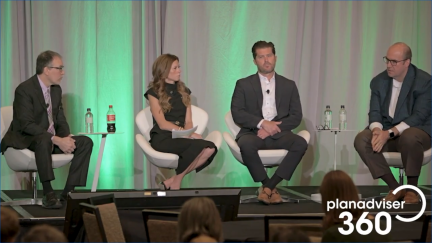Want the latest retirement plan adviser news and insights? Sign up for PLANADVISER newsletters.
NEPC Looks at ROI of Managed Account Savings Advice
In a new white paper, the consultancy walks through the benefit versus cost of personalized savings advice from defined contribution managed accounts for early to mid-career savers.
Consultancy NEPC’s defined contribution team argued in a white paper released Monday that the return on investment from one-time savings advice for early to mid-career participants in a managed account will not offset the ongoing fees. Instead, the firm advocates for plan sponsors to consider automatic escalation as a way to boost savings outcomes for participants.
The firm’s DC team, which has shown caution about managed accounts in the past, published its findings in a paper titled “The Real ROI: Analyzing Savings Advice in Managed Accounts.” In the analysis, the consultancy considers the value of one-time savings advice used at the start of investing by an early to mid-career participant in a managed account with an ongoing fee of 30 basis points, or 0.30%.
The team writes that the “bulk of savings advice benefit for a participant materializes in the first year (and is further augmented by the annual compounded market returns on those savings).” After that first year, it assumes the primary driver for continued growth is “limited to any merit increases in pay.”
The firm undertook the paper, in part, as it works with plan sponsor clients who are at times “getting pushed to add this feature,” says Mikaylee O’Connor, principal, head of defined contribution solutions at NEPC.
“What we’ve seen is that plan sponsors have over time added this service without necessarily going through the full due diligence process,” she says. “As part of our fiduciary duty in working with clients, we’ve spent time over the last number of years looking into managed accounts and really trying to understand the value add.”
O’Connor joined NEPC in April as Bill Ryan was promoted to DC team leader.
Proponents of managed accounts in DC plans have argued that the investment and ongoing advice solutions provide personalized attention at a lower cost than working with an individual financial adviser. In recent years, providers and recordkeepers have also been bringing to market dynamic, or hybrid managed accounts that flip participants into them when closer to retirement, when they have more to manage and need more help.
In a piece published earlier this year in PLANADVISER in response to a Wall Street Journal article about managed accounts, Steve McCoy, the CEO of managed account provider iJoin, rebutted arguments that fees are too high for managed account services. He made the case that fees are as low as 10 basis points by some providers, and that the investment benefits they offer are best compared to actively managed TDFs.
Seeking Personalization
In separate research published by Vanguard on Monday, the firm noted that 43% of plan sponsors offer a managed account program—a figure that rises to 80% for plans with over 5,000 participants. The firm also noted that 7% of participants use a managed account, as compared to 58% who are invested in a target-date fund.
O’Connor agrees that plan sponsors often want to offer more personalized solutions to participants. But she urged them to think carefully about how best to personalize.
“I think for some who are approaching retirement who have multiple pools of money and want to think about their overall financial picture, they may be a good candidate for some sort of personalized service,” she said. “But for the vast majority of people, I just don’t think that is going to happen; and we see that with managed accounts, people are not engaging with the service as they should be.”
In its paper, NEPC looked at four participant models with varying starting salaries and DC balances. It assumed that each participant received a 2% increase in savings from the managed account advice in the first year, and subsequently each year after without any further advice.
A participant making $50,000 a year would, for example, save an additional $1,000 in the first year. However, after that initial boost, additional savings would come from annual merit increases and market returns on savings; those would be substantially less, in a range of $80 to $95 a year.
“The reason for the negative ROI is that the managed account fee was based on the participant’s DC assets,” NEPC’s team writes. “As the participant’s assets grew faster than their salary, the incremental year-over-year rise in fees was greater than the incremental year-over-year increase in the participant’s salary, and therefore savings. This was especially true for participants younger than age 40 whose managed account investment allocation would have high exposure to equities, similar to a target-date fund.”
Due to these “diminishing returns” from the savings advice, NEPC makes the case for a different fee structure. In its proposal, the firm would have “savings advice should be a one-time charge” with subsequent fees being reduced.
Automatic Escalation
O’Connor went on to say that, in such a model, a managed account could offer a more a la carte service, in which a participant could opt-in for additional services.
“It can be on the participant to say I’m willing to pay something additional, which is a much better model than having everyone pay the higher fee,” she says.
NEPC then compared the results of a plan sponsor implementing automatic escalation for plan participants.
In one example, the firm considered a plan that auto-escalates at 1% annually up to a 10% ceiling, which would create an estimated compound growth in DC assets by over 14% after 15 years. It put a participant in that plan after being in a managed account and found that “this participant gains more value from auto-escalation than from the savings advice provided through managed accounts.”
In the separate Vanguard research, it found that 69% of plan sponsor clients use automatic savings rate increases.
“A plan sponsor could help almost their entire population by increasing their savings rates for free by just implementing auto-escalation,” O’Connor says. “You’re really putting people on a good path without them paying for it.”
You Might Also Like:

Managed Accounts, TDFs or Both?

Employees, Employers Disclose Major Gaps in Retirement Awareness


